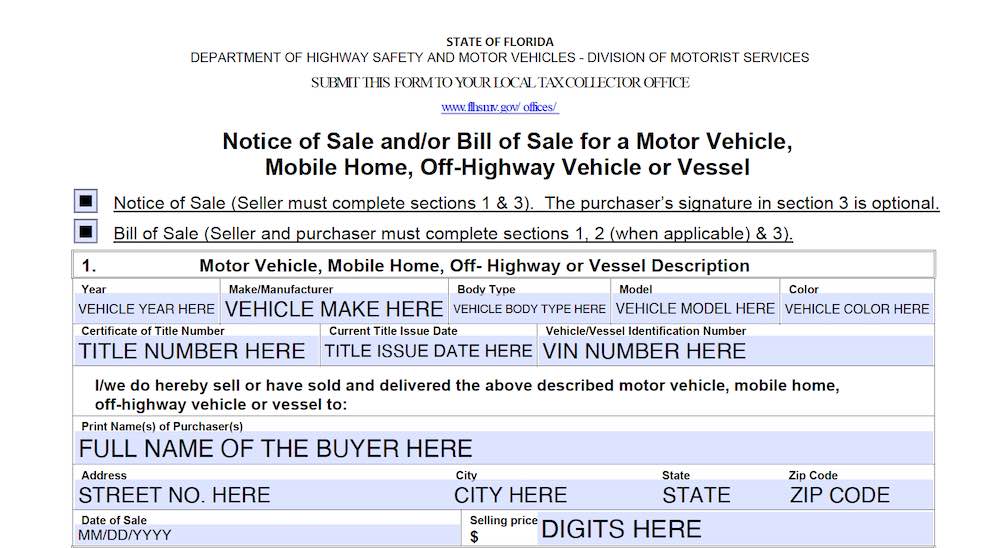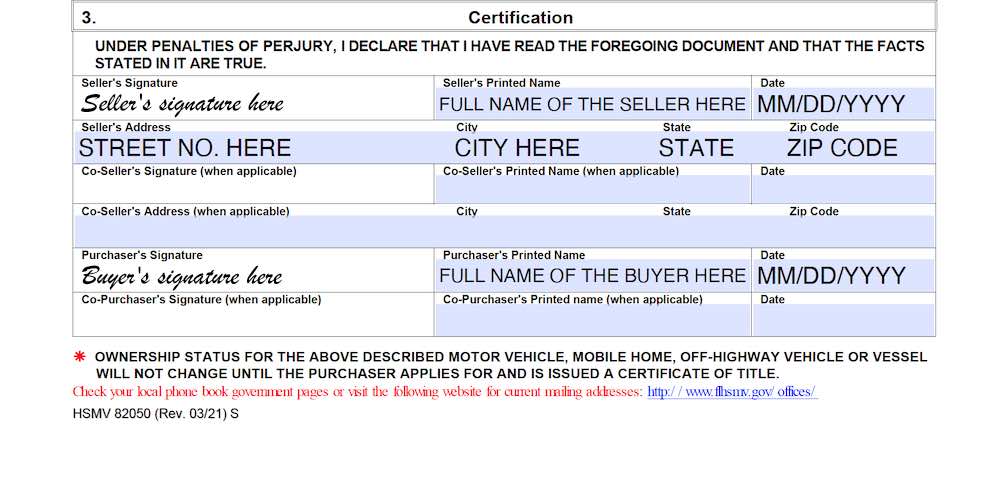In Florida when you buy or sell a vehicle you should complete a Bill of Sale Form. The Bill of sale acts as a record of a vehicle sale and includes details of the transaction. The State of Florida has some legal specific requirements about the Bill of Sale.
The following information should appear on the Florida Bill of Sale Form:
- Name and complete address of the seller.
- Name and complete address of the buyer.
- Complete vehicle description, including Vehicle Identification Number (VIN), make, model, year and body style.
- Vehicle odometer reading at the time of sale.
- The sell price.
- Date of sale.
- Signature of the seller and the buyer.
- Notary public seal identifying the seller’s and the buyer’s signature is recommended.
Florida Bill of Sale Form
Florida’s Department of Highway Safety and Motor Vehicles (DHSMV) provides a state-approved, printable Florida Bill of Sale Form.
This form is intended for residents buying and selling vehicles in the State of Florida. Also this form serves multiple purposes for both the seller and the buyer.
The full name of this form is Bill of Sale Form Notice of Sale and/or Bill of Sale for a Motor Vehicle, Mobile Home, Off-Highway Vehicle or Vessel Form HSMV 82050.
When acting as the Notice of Sale, this form notifies the DHSMV that you have sold your vehicle. Above all this form frees you from liability. In particular it’s especially important during the period between selling the vehicle and the new owner titling the vehicle.
Also the form HSMV 82050 serves as an Odometer Disclosure Statement as well. By federal law you have to record the mileage for any vehicle that is a model year 2011 or newer and below 16,000 pounds.
The Department of Highway Safety and Motor Vehicles requires you to submit this form to your local tax collector’s office. You have to do this within 30 days of selling your vehicle.
In short a Bill of Sale Form is not a motor vehicle title and doesn’t replace a title transfer!
Tips for Vehicle Sellers
As a seller you can sell your vehicle without using a Bill of Sale, but you must provide the completed vehicle title to the buyer. So complete the vehicle title and give it to the buyer. The title is required to complete the title and registration. Make sure all information matches, including the vehicle identification number and odometer reading.
The seller should strongly consider completing a Bill of Sale Form with the buyer and keeping a copy for safety.
The seller should remove the license plates because Florida license plates stay with the driver, not the vehicle. The plates can be transferred to another vehicle (avoiding the $225 fee for the initial registration) or can be left to the tax collector’s office. The seller should do one or the other, because if the plates aren’t used this can lead to license suspension!
If you want to transfer your plates to another vehicle before selling your vehicle you should apply for temporary tags at your tax collector’s office. The State of Florida issues temporary tags for the “for sale” vehicle for the purpose of display and test driving. These tags are good for 30 days.
Tips for Repaired Vehicles
If you repair and/or rebuild salvaged vehicles to drive or sell you must first apply for a Salvage Title using the Application for Salvage Title/Certificate of Destruction Form HSMV 82363.
For anyone rebuilding and driving or selling a salvaged vehicle, there are questions related to whether the vehicle is rebuildable and how much repairs would cost. If repair costs are less than 80% of the cost to replace the vehicle, you can request a Salvage Rebuildable Title.
Just as with any other vehicle, if you’re selling or buying a salvaged vehicle, you aren’t required to use the Bill of Sale. However, completing a Bill of Sale is highly recommended for the same reasons listed above.
Florida doesn’t have a special salvaged vehicle Bill of Sale Form, so you can use the Notice of Sale and/or Bill of Sale for a Motor Vehicle, Mobile Home, Off-Highway Vehicle or Vessel Form HSMV 82050.
Tips for Vehicle Buyers
As a buyer it is recommended to complete a Bill of Sale Form and having it notarized if possible. The buyer should never leave without the vehicle title after the transaction. The title transfer and registration can’t completed without the vehicle title. A Bill of Sale isn’t enough, and completing a Bill of Sale Form is not a title transfer!
Another key point is that the buyer should verify if the vehicle’s description is accurate and to check the make, model, year, body style and color. Also the buyer should check also that the odometer reading and VIN are the same on the vehicle as recorded on the title.
Consequently the buyer should be aware of the vehicle’s past before buying it and should search in the title for words like “Junked”, “Warranty Returned”, “Original Taxi” or something similar.
The buyer should be sure everyone who needs to sign the title does so. Multiple names separated by “OR” means either party can sign the title, but “AND” or a forward slash (“/”) means both parties must sign the title. The buyer can title and register the vehicle and apply for license plates within 30 days of the transaction.
The State of Florida prohibits driving any vehicle without tags or license plates so the buyer must apply for a title transfer, car registration, and license plates BEFORE driving the vehicle. The DHSMV recommends either having the previous owner drive the vehicle to your property or having the previous owner drive the vehicle to the tax collector’s office with you.
The buyer must bring the applications for title and registration to the tax collector’s office, as well as proof of insurance and payment for the applicable taxes.
How to complete the Florida Bill of Sale Form
The Florida Bill of Sale Form is composed of three sections and can act both as a Bill of Sale and/or a Notice of Sale. Below you’ll learn how to fill out this form:
Section 1
The first section contains the vehicle information. Here you’ll need to fill out the Year, Make, Body type, Model, Color, Certificate of Title Number, Current Title Issue Date and the VIN or the Vehicle Identification Number. Further you need to fill out the full name of the buyer. The buyer’s name must be PRINTED – this means to use only Capital Letters to write BUYER’S NAME. After these details fill out buyer’s street address, buyer’s city, state and ZIP code. Lastly fill out the date of sale and the selling price:

Section 2
The second section represents the Odometer Disclosure Statement at the time of transfer. You are required to complete this section for any vehicle that is a model year 2011 or newer and below 16,000 pounds. In this case use only digits, no tenths, fill out the date and check the corresponding box regarding the mileage reading:

Section 3
The third section is a Certification of the information contained in this Bill of Sale. First complete seller’s signature, the full name of the seller and the date. The name must be PRINTED. So this means to use only Capital Letters to write SELLER’S NAME. Then fill out seller’s street address, seller’s city, state and ZIP code. After these details fill out the buyer’s signature, the full name of the buyer and the date:

Please note that you can fill out this Bill of Sale form by hand. However don’t forget to use a pen and not a pencil. If you are filling out this form on your device (phone, tablet, computer) this form is a fillable PDF that works best with Adobe Acrobat Reader.
Learn more about the Florida Department of Highway Safety and Motor Vehicles
For more information go to Florida Department of Highway Safety and Motor Vehicles (DHSMV)
The Department of Highway Safety and Motor Vehicles (DHSMV) comes into contact with nearly every Floridian as well as many visitors of the state.
People get a driver license to operate their vehicles or for photo identification purposes. They register and title their automobiles, mobile homes, and boats. They may receive assistance from the Florida Highway Patrol if they are involved in a crash or their vehicle breaks down along Florida’s highways. Often the Patrol will remind drivers to slow down and buckle up.
There is more to DHSMV than meets the eye. DHSMV’s mission is to provide highway safety and security through excellence in service, education and enforcement. Its members around the state are dedicated to accomplishing this mission.